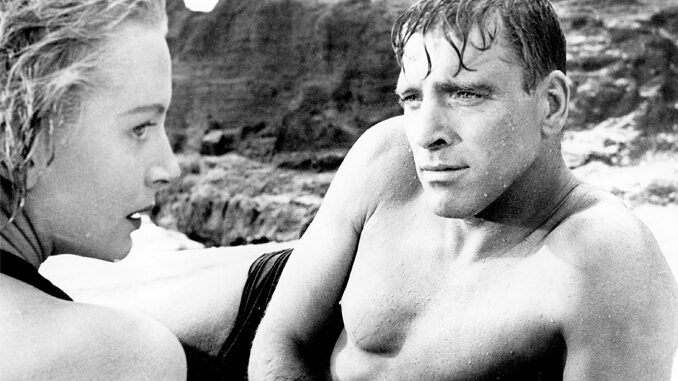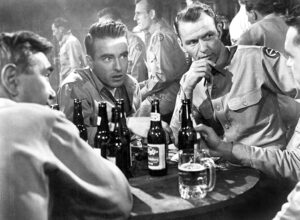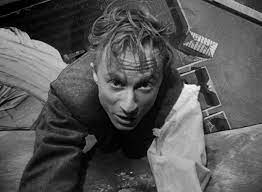
by Kevin Lewis
From Here to Eternity (1953) is a transitional film in the American motion picture industry. It is probably the first major Hollywood release to express anti-establishment themes and the new morality. In his book The Fifties (1994), historian and journalist David Halberstam states that the 1950s was not a quiet decade — and this film made a lot of the noise. Questioning authority and acting upon sexual inclinations, however, were already a part of post-war American society, a by- product of not just World War II but the Great Depression. But suddenly, it was depicted on the big screen.
Perhaps if the movie was not derived from a best-selling book that expressed the wartime experiences of many a member of the Armed Forces — both male and female — it may not have been so bold. From Here to Eternity was based on the 1951 eponymous tome by James Jones about the US Army troops stationed at Pearl Harbor just before the December 7, 1941 attack. It was one of a trio of distinguished World War II novels published in the immediate post-war years, the others being The Naked and the Dead (1948) by Norman Mailer and The Young Lions (1948) by Irwin Shaw.
But not even the Motion Picture Production Code’s Breen Office emasculated the subject matter of the film. Two of its leading characters, an Army sergeant and an officer’s wife, were involved in an extramarital affair. The officer’s wife was well known for being promiscuous. Another woman was a prostitute in a thinly disguised brothel, living with a soldier. One other soldier was openly rebellious (and in the book was a male hustler). They were portrayed as sympathetic characters, and although they all ended up in tragic circumstances, it was not because of their adultery. It was the war.
When it premiered 60 years ago in August 1953, at the height of the Cold War, the American film industry was subject to scrutiny by the House Un-American Activities Committee’s (HUAC) investigation of Communist influences. The Korean War ended in a stalemate truce that year, a fulfillment of the presidential campaign promise by President Dwight D. Eisenhower, the hero general of World War II.
From Here to Eternity was a brave project for Harry Cohn, president of Columbia Pictures, in such tense times. Hollywood was accused of undermining the morale and morality of the public, and HUAC dragged the moguls to government hearings demanding that they reveal all suspected subversive ideas among its employees. But Cohn, who fired suspected left-wingers, stood behind his project and supported his director, Fred Zinnemann, already in the right-wing crosshairs for directing High Noon (1952).
Regardless, the film went on to gross $18 million — in the television age, yet — and its success showed Hollywood that self- appointed censors had no real power to dictate taste; the public wanted provocative movies.
Columbia was the poorest of the major studios, with no sizeable stable of stars, and had to produce ‘A’ movies on a shoestring. It ultimately held the record among the studios at the time for Best Picture winners from the Academy of Motion Picture Arts and Sciences. The budget for From Here to Eternity, which became the fourth Best Picture winner for Columbia, was capped at $2 million, which was a financial stretch for the studio. The only way Cohn could produce the film was with cooperation from the Army, which the project pilloried.
Cohn, along with producer Buddy Adler, screenwriter Daniel Taradash and director Zinnemann — all of whom would win Oscars — had to capitulate on one point: The Capt. David Holmes character (Philip Ober) would have to be forced to resign in lieu of a court martial for hazing recruits (In the book, he was promoted to major when war was declared.) The homosexual hustling of Hawai’i residents by Army recruits of was also eliminated (a TV miniseries version in 1979 restored this last plot point).
Interestingly enough, if Cohn had prevailed on the casting, the film may not have been as memorable. He wanted one of his new stars — the beefcake Aldo Ray or John Derek — to play the troubled boxer Pvt. Robert E. Lee Prewitt, and Edmond O’Brien to portray Sgt. Milton Warden. Joan Crawford was signed to play Karen Holmes, the officer’s easy wife, and Julie Harris was preferred to play the nightclub hooker Lorene. Eli Wallach was set to play Pvt. Angelo Maggio.
But Cohn acceded to Zinnemann, who delivered the casting lineup of the decade, each one cast against type: Montgomery Clift, Burt Lancaster, Deborah Kerr, Donna Reed and Frank Sinatra, respectively. All of them were nominated for acting Oscars, one of the few times five performers were nominated for one film.

Legend has it that Sinatra, then a virtual has-been in the industry, begged Cohn for the role of the tragic Maggio, even offering his services gratis, and that his purported ties to organized crime garnered him the part. Zinnemann refuted this story, stating that, in reality, it was the intercession of Sinatra’s then-wife, film star Ava Gardner, with Cohn that secured him the role, which became his comeback and earned him an Oscar as Best Supporting Actor. Cohn reportedly only paid Sinatra around $8,000 for the film.
Ernest Borgnine, as the vicious brig warden who murders Maggio, was another beneficiary of the film. Lancaster, who became one the first star actors to become a major independent producer, made Borgnine a star and an Academy Award winner by casting him as the Bronx butcher Marty in the Oscar-winning film of the same name in 1955.
Both post-production Oscars were awarded to From Here to Eternity, among its eight Academy Award wins. William A. Lyon won for Best Film Editing, his first of two Oscars (the other being for 1955’s Picnic), and multiple-Oscar winner John A. Livadary scored again for Best Sound Recording. Burnett Guffey, ASC, won the Oscar for Best Cinematography. Lyon had an intuitive sense of actor’s timing in his editing; he let the emotions unfold in a natural progression, achieving a documentary-type reality.
The most famous moment in the film is the love scene on the beach between Lancaster and Kerr. Though they are modestly clad in bathing suits and only exchange passionate embraces and kisses in a horizontal position, with Kerr on top, it is more remembered than most love scenes in film history. Perhaps it is the white ocean wave foam rhythmically thrusting itself over their bodies that excites viewers. The sensual scene has been often spoofed or copied in films and television, most notably by Sid Caesar and Imogene Coca on Your Shows of Shows in 1953, and by Jeff Bridges and Rachel Ward in Against All Odds (1984).
But the original sequence in From Here to Eternity is the one that continues to resonate, and is the one we remember, even in this modern era of bare-all sex scenes and gratuitous titillation geared toward the “We saw your boobs” set.





